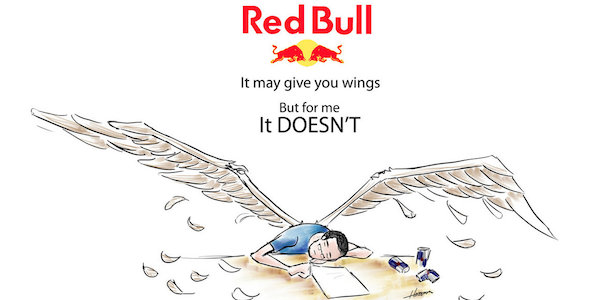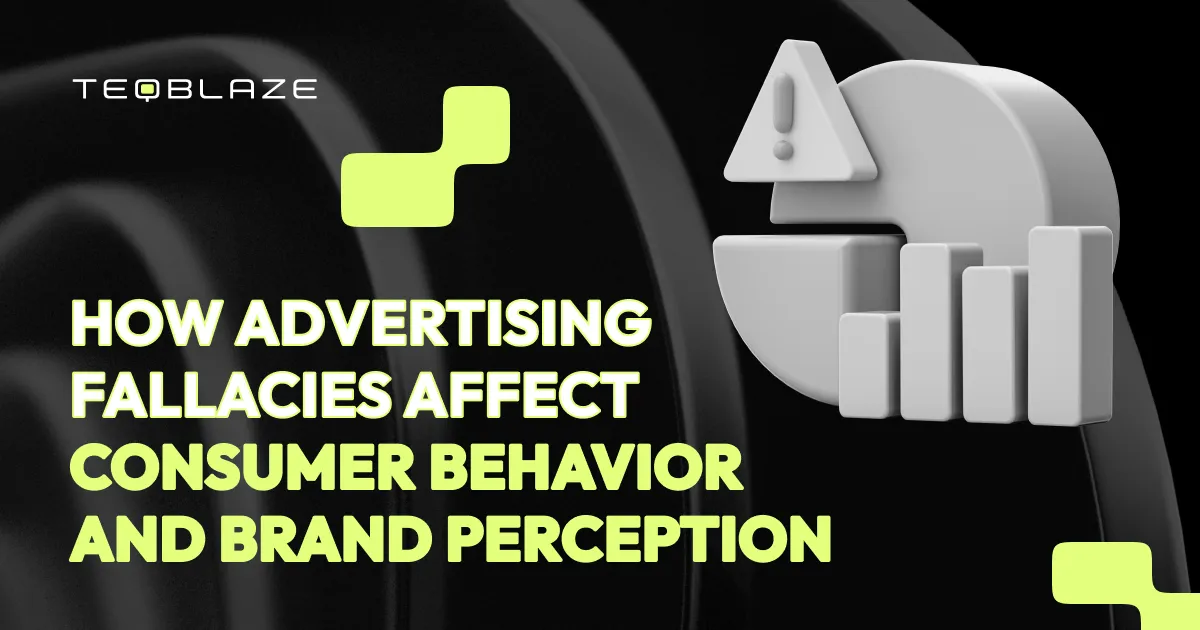It is clear that advertising plays a fundamental role in our lives. Daily, we unintentionally come across products or services that serve as a solution to our problems. Advertising creates in our minds an imaginary image of a product that helps to meet our needs, improve social status, etc. But, at the same time, it is always necessary to ask yourself a question - is this product really necessary? Quite frequently, advertising companies use different techniques that can trick our brains into buying something unnecessary that we weren't planning to buy. This is called fallacies in advertising. Let's now take a deeper look at this concept alongside the specific fallacy examples in the media.
What are fallacies in advertising, and why do advertisers use it?
Fallacies in ads mean misleading arguments used to manipulate consumer perceptions and behaviors. They influence cognitive biases and use emotional triggers to create a false sense of urgency, desirability, or necessity for a product or service. The allure of ad fallacies lies in their effectiveness. They can be highly persuasive, especially when targeted at specific demographics. Advertisers often use them to:
Create a desire for a product, even if it's unnecessary
Build brand image
Drive sales.
However, the use of advertising fallacies is a risky strategy that can damage a brand's reputation and lead to boycotts or negative word-of-mouth.
5 Key types of fallacies in advertising
There are several ways advertisers can influence the target audience with the help of fallacy in advertising.
Emotional impact
Advertising companies often use emotions as one of the fallacy advertisement examples to get consumers interested. Ads with fallacies include beautiful pictures, attractive colors, and sounds that evoke positive emotions.
For example, car advertisements may demonstrate attractive roads and happy people driving a new auto. This can persuade the audience to buy that car, even if they can't afford it or have a new one.
Manipulation of statistics
Advertisers also use fake numbers to convince us to buy their products.
For example, an advertisement for a weight loss product may use statistics that show that 90% of people who consume the product lose weight. But at the same time, the company may hide the fact that these results can only be achieved when the product is combined with regular exercise and a healthy diet.
Psychological techniques
Other examples of fallacies in advertising include psychological techniques that influence our emotions and motivation. One of the most common techniques is the creation of a sense of lack. Companies often use such slogans as "Buy now before it's too late!" or "Hurry, there are only a few days left!" to create a sense in consumers to order something immediately and not miss the opportunity.
Other common ad hominem advertisement examples include the usage of emotions. Advertisements with logical fallacies that evoke feelings are often more effective than those that simply inform consumers about a product. Advertising companies use a variety of emotions, including joy, fear (one of the slippery slope fallacy examples in advertising), and anger to draw attention to their products. For example, car advertisements often use images of prestigious cars to evoke a sense of success and appeal to potential buyers. They can also utilize music and images to evoke a sense of freedom and adventure.
Furthermore, companies utilize psychological techniques to evoke appreciation in consumers. For example, cosmetic ads may feature slogans such as "We care about your beauty" to show that the company appreciates its customers and is willing to do whatever it takes to make them feel attractive.
What's more, advertisers can manipulate by stimulating feelings of guilt or fear to get viewers to buy a particular product. This method is called a slippery slope advertisement. Examples of logical fallacies in advertising are advertisements for insect repellents that may use images of dangerous insects and warn of possible health hazards. And insurance company advertisements may use images of accidents to show that consumers could lose everything they own without insurance.
Authoritative opinion
Using celebrities as opinion leaders is another common technique of ads with logical fallacies. Logical fallacies examples in ads feature hiring celebrities from the world of sports, movies, music, and other niches to promote the product. Celebrities have a great influence on public opinion. Such logical fallacies examples in ads lead to the great effectiveness of an advertising campaign.
Illusion of happiness
Advertising companies can apply the images of happy people to create the illusion that buying their product will lead to satisfaction.
Advertisers often use images of happy families to create the fallacy that their product will bring family joy. An advertisement for dairy products might also show a happy family enjoying a healthy meal, or an advertisement for cosmetics might show a gorgeous mom using the product to look even better. The use of such images can lead consumers to associate the product with positive emotions and memories. However, it is not always the reality.
Now that you know how advertising uses logical fallacies and what the most common fallacies are, we can go through some real-life examples.
9 Real-life examples of advertising fallacies
Next, we present examples of logical fallacies in the media from giant brands that were sued.
Nutella
Everybody's favorite chocolate paste is popular among both children and adults. But the reason for the lawsuit was a marketing move that misled consumers (later the creators of Nutella themselves agreed with this). In 2012, Ferrero USA (the creators of Nutella) was ordered by the court to pay more than 3,000,000 dollars to a California resident who claimed that she did not realize the harm of this paste and gave it to her child. Nutella's advertising presented the product as a healthy breakfast option. And it contradicted the information on the label (the amount of sugar did not benefit consumers).
In addition, Ferrero USA lost a class action lawsuit against parents who also claimed they were misled by the ads. Ferrero has since changed its strategy and now lists the sugar content on the front of the can.
Red Bull

13 million dollars - that's how much the company had to pay to compensate for the discovered falsification. Capturing the essence of the lawsuit? The activist group that sued the company claimed they were duped - Red Bull drank, and the wings never grew.... There was also no evidence that the drink improves performance and concentration.
Skechers
The brand was fined 40 million dollars (+ 5 million dollars that went to deceive customers) for unfair advertising of sneakers. The advertisements (banners and videos) claimed that wearing Skechers toning sneakers would help to lose weight and strengthen leg and abdominal muscles without additional training. The company even cited clinical studies, which it later turned out were conducted by the husband of one of Skechers' marketing executives and for which he was paid.
Reebok
Reebok paid the 25 million-dollar compensation for the EasyTone and RunTone sneakers. The ads claimed that they helped pump up the muscles in the legs and buttocks while walking. However, the US Federal Trade Commission did not agree with it and recognized the advertisement as misleading.
Apple
Italian authorities have fined Apple 10 million euros for an advertising campaign that claimed that the iPhone model can be put into water up to 4 meters deep for 30 minutes to 2 hours without damage. Except they didn't mention a couple of BUTs:
The tests were conducted under laboratory conditions (i.e., smartphones were dipped in clean water);
The advertising campaign did not warn that the warranty on "drowned" iPhones did not apply.
Volkswagen
15 billion dollars - that's the amount the automobile giant paid by court order. The US Federal Trade Commission filed a lawsuit against Volkswagen. They accused the company of deceiving consumers whose cars were equipped with software that underestimated the number of toxic gases emitted into the air. However, advertising promised "clean diesel."
Calvin Klein
The advertising poster based on Leonardo da Vinci's painting "The Last Supper" cost Calvin Klein 1 million dollars. The ad depicted models wearing Calvin Klein jeans. The Catholic Church of France filed a lawsuit against the company and won the case - the advertisement was not only banned and withdrawn but the company was also fined.
AXE
40,000 dollars - that's how much the man estimated his moral damage from the use of AXE deodorants. Why? In seven years of using AXE products, not a single member of the fair sex had paid attention to him. Although advertising claims that AXE products attract women.
RJ Reynolds Tobacco Company
One of the most massive lawsuits in history was 10 billion dollars. Then around 8 thousand citizens accused RJ Reynolds Tobacco Company of deluding information about the damage of tobacco. According to them, after the shady advertising, they were "hooked" on nicotine.
Ethical advertising as a competitive advantage
Ethical advertising, however, offers a refreshing alternative by setting companies apart from their competitors. As consumers become more discerning and values-driven, they are paying attention beyond catchy slogans to assess the integrity of the brands they support. Ethical advertising, which emphasizes honesty, transparency, and respect for the consumer, resonates deeply with this new generation of conscious consumers. Brands that are straightforward and honest in their marketing efforts not only attract more loyal customers but also build a reputation that stands the test of time.
Since consumers are looking for authenticity more than ever, they are more likely to support brands that are truthful in their claims and that align with their values and beliefs. Ethical brands often benefit from positive word-of-mouth, as satisfied customers are eager to share their experiences with others. This organic promotion can lead to long-term benefits, such as a dedicated customer base.
In a market where consumers are becoming more aware and concerned about ethics, knowing real-life examples of fallacies in media is a strategic move. This is where a reliable provider of white-label programmatic platforms comes into play, ensuring that your ads are transparent. Such platforms are equipped with advanced algorithms and data analytics that prevent misleading claims, ensuring that ads are served in a context that aligns with both the brand’s values and consumer expectations. This not only enhances the effectiveness of campaigns but also protects the brand’s reputation in contrast to commercials with fallacies.
Consider TeqBlaze as your trusted partner
TeqBlaze is a leading provider of white-label programmatic platforms that emphasize ethical advertising practices. The company offers a suite of services designed to combat common logical fallacies examples in media, ensuring that brands can engage with their audience authentically and avoid commercials with fallacies. These include tools for precise audience targeting, fraud detection, and real-time analytics, allowing brands to deliver messages that resonate with consumers while avoiding manipulative tactics.
For instance, a key figure in digital advertising was facing challenges in reaching its target audience with relevant and truthful messaging, leading to decreasing returns on their advertising investments. TeqBlaze’s white-label SSP+Ad Exchange programmatic platform stepped in to overhaul the brand’s digital advertising strategy. By utilizing TeqBlaze’s cutting-edge audience segmentation and real-time analytics, the company managed to create highly targeted campaigns that resonated with specific consumer groups without resorting to misleading tactics. This approach not only improved the relevance of their ads but also boosted customer engagement and trust. The campaign result was a 30% increase in conversion rates. It significantly improved the brand’s reputation among its audience, illustrating the power of ethical advertising in driving business growth.
Companies like TeqBlaze are helping AdTech brands navigate recent ads with fallacies by prioritizing transparency and integrity. With a reliable programmatic partner with ethical advertising strategies, you will not only achieve immediate success but also secure your future in a market that increasingly values authenticity. The case study from TeqBlaze demonstrates how ethical practices, supported by the latest technologies, drive significant improvements in both performance and brand reputation.
Final word
Fallacies in advertising can be effective in the short term, but in the long run, they destroy consumer trust and lead to poor brand reputation. Advanced tools provided by TeqBlaze, including audience targeting, real-time analytics, and robust fraud detection, ensure that advertising remains truthful, relevant, and aligns with the values of modern consumers.
With the help of such tools, you can not only prevent fallacies in your ad placements but also enhance your market position by following ethical standards. Since consumers are increasingly making choices towards brands that prioritize honesty and transparency, this approach leads to a significant competitive advantage. Ethical advertising, paired with cutting-edge technology, allows your ad business to foster meaningful connections with your audience, leading to a loyal customer base that maintains long-term growth and success.

 Anna Vintsevska
Anna Vintsevska





